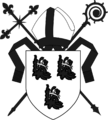Lawrence Booth facts for kids
Quick facts for kids The Most Reverend and Right Honourable Lawrence Booth |
|
|---|---|
| Archbishop of York and Primate of England | |
| Appointed | 1 September 1476 |
| Reign ended | 19 May 1480 |
| Predecessor | George Neville |
| Successor | Thomas Rotherham |
| Other posts | Lord Chancellor and Keeper of the Great Seal |
| Orders | |
| Ordination | 1441 |
| Consecration | 25 September 1457 |
| Personal details | |
| Born | c. 1420 Barton, Lancashire, England |
| Died | 19 May 1480 (aged 60) Cawood Castle, Yorkshire |
| Buried | Southwell Minster |
| Denomination | Catholic |
| Previous post | |
| Alma mater | Pembroke Hall, Cambridge |
| Coat of arms |  |
Lawrence Booth (born around 1420, died 1480) was an important English leader. He served as a bishop and later as the Lord Chancellor of England. This was a very powerful government job. After that, he became the Archbishop of York, a top position in the Church.
Contents
About Lawrence Booth
Lawrence Booth was born around 1420 in Barton, Lancashire, England. His father was John Booth, who was the lord of the manor of Barton. Lawrence also had a half-brother named Sir Robert Booth.
His Education and Early Career
Lawrence Booth studied civil law and canon law at Cambridge University. He earned a special degree called a licentiate. Later, he received a Doctor of Divinity (D.D.) degree.
In 1450, he became the Master of Pembroke Hall at Cambridge. He held this important position until he died. He also served as the Chancellor of Cambridge University. While at Cambridge, he helped start new schools for arts and civil law.
Lawrence Booth's career was helped by his half-brother, William Booth. William was a bishop and later became the Archbishop of York. In 1449, Lawrence joined St Paul's Cathedral in London. By 1456, he became the Dean of St Paul's. He also held positions at York Minster and Lichfield Cathedral. From 1454 to 1457, he was an Archdeacon.
Roles in Government
Lawrence Booth was not just active in the Church. He also played a big role in the English government. He was a chancellor to Margaret of Anjou, who was the Queen of England.
Around 1456, he became the Keeper of the Privy Seal. This was another important government job. In the same year, he was also chosen to be a tutor and guardian for the Prince of Wales. He served as Lord Privy Seal until 1460.
Bishop of Durham
On September 25, 1457, Lawrence Booth became the Prince-Bishop of Durham. This was a very powerful role. A Prince-Bishop had both religious and political power in their region.
Adapting to New Rulers
Lawrence Booth came from a family that supported the Lancastrian side in the Wars of the Roses. However, he also built good relationships with the Yorkists. When King Henry VI lost power, Booth adjusted to the new situation.
In April 1461, he showed his loyalty to King Edward IV. Soon after, Booth helped defeat a rebellion in northern England. King Edward even named him his confessor, a trusted advisor.
Although he briefly lost control of the Durham region, he got it back in 1464. He was one of the few religious leaders who was never imprisoned during that time. He continued to work in Edward's government.
Lord Chancellor and Archbishop of York
On July 27, 1473, Lawrence Booth became the Lord Chancellor. He served in this role until May 1474. In October 1473, he led a group to Scotland. Their mission was to sign a marriage agreement for King James III's son and King Edward's daughter, Cecily.
In 1476, Lawrence Booth was moved to the see of York. This was the same important position his half-brother had held. He was the only religious leader to be promoted to a higher office after King Edward IV became king.
Lawrence Booth served as the Archbishop of York until he died on May 19, 1480. He was buried next to his half-brother, William Booth, at the Collegiate Church of Southwell. Both brothers had given a lot of money to this church.
Images for kids
See also
- Booth baronets
- York Minster


